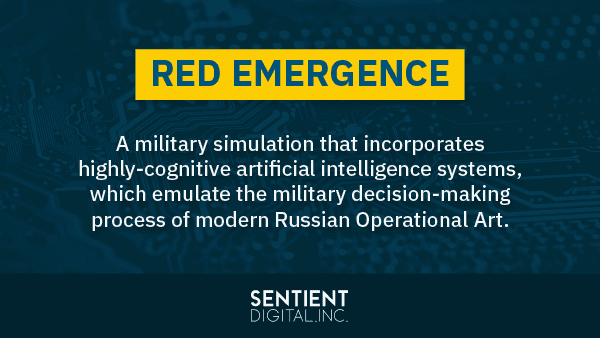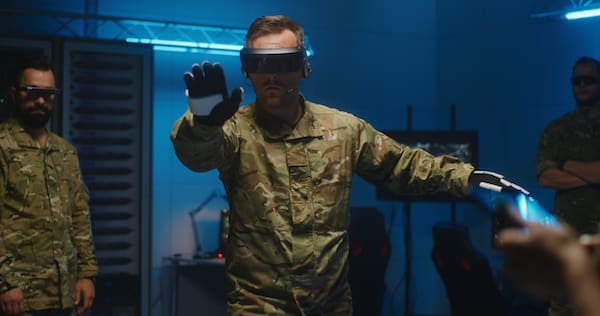At Sentient Digital, Inc., we, along with our subsidiary, RDA, are honored to support the warfighter as a major focus of our work and our company culture. As a technology solutions provider, we build the systems and develop the software that keep the U.S. military working at maximum efficiency. When the military has a new technology-related initiative, we embrace the challenges it presents. Here we detail just such an initiative, and how our team looks forward to applying our skills to the task at hand.
DoD Cloud Initiative
The United States Department of Defense recently indicated its intention to invest heavily in the cloud as a virtual repository of its training and software. With this Joint Warfighting Cloud Capability initiative comes a number of formidable challenges, regarding the technology itself as well as security protocols around it.
The Joint Warfighting Cloud Capability is a cross-branch, multi-award contract vehicle designed to promote a variety of objectives, including, in the Department of Defense’s words:
- global accessibility
- available and resilient services
- centralized management and distributed control
- ease of use
- commercial parity
- elastic computing, storage, and network infrastructure
- advanced data analytics
- fortified security
- tactical edge devices
The DoD has awarded contracts to Amazon Web Services Inc. (AWS), Google Support Services LLC, Microsoft Corporation, and Oracle to set up the cloud that will facilitate these objectives.
Simulations and Software Now Stored in a Classified Physical Facility Can Be Stored In The Cloud
At the core of this focus on cloud capabilities is the desire for efficiency. Taking what is now only accessible by traveling to a physical location and making it accessible from anywhere could significantly enhance the utility of these simulations by making them easily available to the right people in a variety of locations, while also protecting them from bad actors.
“Access points must be secure and software systems must have robust security protocols if they go outside the Secure Cloud (IT Challenges)…but overall I see this as the ‘Next Big Thing’ for DOD,” says Sentient Digital Artificial Intelligence Research Scientist Gene Locklear. Here is a more in-depth look at the opportunities this initiative presents for Sentient Digital and RDA to support the warfighter.
Cybersecurity Challenges: Opportunities for Cybersecurity Experts To Support The Warfighter
Bringing software and training simulations that were previously only available offline at secure facilities onto the internet entails massive cybersecurity and national security challenges. DoD intends to take a zero trust approach to cybersecurity for the cloud, a shift from its previous “perimeter security” approach.
The perimeter security approach involves reinforcing your network with a figurative “perimeter” of security measures to restrict access into the network from the outside. It focuses on where the request for access is initiated; if it appears to be from a trusted location, access tends to be allowed, whereas if requested from an untrusted or unknown location, the access tends to be denied.
Zero trust, by contrast, looks at every request individually, without regard to whether it is initiated from a trusted location. Zero trust means there are no trusted locations. No one can get in without demonstrating they are authorized to access the requested information. DoD is currently in a transition to zero trust that it plans to complete by 2027.
Military Productivity Software and Training Simulations—By Subscription
One of the most exciting opportunities for DoD contractors of this move into the cloud is the potential to develop training simulations within our organizations, and, with approval, place them on the cloud for the military to access. This would eliminate the step of having to bid and win contracts to design specific training programs. By contrast, training simulations could be developed continually and submitted for approval to place on the cloud. The military could access these trainings on demand at their convenience with an ongoing subscription in place.
The DOD’s initiative to develop a secure, cloud-based storage system, that facilitates independent military contractors in uploading their software applications, is a major advancement in the prototyping and development of military simulations. The results of this initiative, to be known as AWS-Secret Region, allows military contractors, like Sentient Digital, to leverage the benefits of cloud computing while meeting the strict security and compliance requirements for working with Secret-level information.
The recent advances in the implementation of the AWS-Secret Region have helped Sentient Digital to create a more advanced model of wargaming in a multi-domain environment. This new more robust model involves not only a platform for simulating tactical and operational-level combat, but also one which incorporates an advanced hybrid-state machine and behavior tree-based AI as the adversary. This new AI, thanks to a secure information system, can now leverage real-world data, which is often classified, to enable it to “improve itself” using a variety of machine learning techniques, such as ensemble and reinforcement learning.
Sentient Digital believes strongly in the need for such a platform, because current military simulations, while incorporating some limited AI systems/techniques, still rely mainly on human control for both the U.S. (BLUFOR) and the enemy (OPFOR) forces. While having human U.S. military participants on the U.S. side is optimal, the reliance on other U.S. military participants to emulate OPFOR tactics and operational art is far from ideal. Though U.S. military personnel can “play” the opponent, their often lack of “sufficient indoctrination” with OPFOR tactics, weaponry, and operational concepts detracts from the “real world-ness” of the simulation.
Therefore, the core technical problem, in building a reliable simulation for U.S. forces, is creating one which incorporates an enemy that behaves as the OPFOR does in both actions and “style.” The key tenet, in that creation, is having an OPFOR entity that is an expert in all aspects of OPFOR weaponry and tactics, as well as free of U.S. doctrinal biases. The best way to develop this OPFOR, short of having our near-peer adversaries participate, is to provide the AI with the “operational art and tactics” of our adversaries.
Then, from this knowledge base, allow the AI to develop its own tactics, techniques, and procedures completely free from U.S. doctrinal influence. Ultimately, this will support the creation of an adversary that incorporates a model that U.S. participants understand, but uses that model in ways that are not predetermined. This nondeterminism will force the BLUFOR side to constantly adapt to unforeseen OPFOR tactics and strategy. The resulting adaptation to the OPFOR will allow for emergent tactical and operational art that may well have not been discovered otherwise.

Sentient Digital’s Red Emergence Simulation
At Sentient Digital we are currently developing a military simulation known as Red Emergence, which is specifically designed to address this problem as its core objective. Red Emergence is designed using the Unity game development platform, and utilizes the platform to handle graphical depiction of the operational environment and the necessary human-user interfaces. From the Unity development perspective, Red Emergence is a single player, 2D Real-Time Strategy game that simulates modern land combat between the U.S. Army and a “re-imagined,” near-peer Russian Army. The U.S. player’s opponent is a hybrid expert system and multi-agent artificial intelligence. The “game board” is a representation of a military topographical map depicting the military training areas at MCAGCC Twentynine Palms, CA, and Fort Irwin, CA, that is scaled to 1:50,000 and incorporates the Military Grid Reference System (MGRS) for those areas.
Red Emergence is designed to model all aspects of multi-domain operations with a scale of forces down to the individual Company to team-level. The scenarios available in Red Emergence can be tailored by the player (BLUFOR) with included scenarios that cover all standard offensive and defensive operations like movement to contact, deliberate attack, deliberate defense, etc.
In Red Emergence, unlike most standard simulations, the human player creates “missions” for their units, based on the objectives of the scenario, and observes the results of their execution by the “Simulation Manager.” These unit missions are created using a graphical user interface (GUI) that allows the human player to input the details of those missions just as though they were issuing orders in the field.
Additionally, tools provided by the simulation give the human player access to U.S. doctrinal templates for staff planning and order creation. Because the simulation occurs in real-time (time-compression is possible), it can be paused by the human player, so that additional missions can be created, or modifications made to ones that are already executing.
Most notably, Red Emergence provides the ability to both archive and analyze the results of individual scenario outcomes. Thus, this archive serves as a repository for modern combat data. Concurrently, this repository also allows for ongoing hypothesis testing that can be used to model current military situations around the World, and support actual U.S. decisions based on uncertain or incomplete information about an adversary’s strategies, tactics, or operational plans.
Overall, Red Emergence offers a valuable tool set for military decision makers, helping them improve training, assess risks, explore scenarios, optimize resources, evaluate technologies, and enhance command and control structures. By leveraging the sophistication built into Red Emergence, U.S. forces can make informed decisions, enhance operational effectiveness, and increase their readiness to respond to real-world challenges.
The Implications of AWS-Secret Region for Sentient Digital and RDA
This initiative would provide a significant opportunity for Sentient Digital and RDA to further support the warfighter. Our professionals design and develop military training simulation software that leverages technologies such as artificial intelligence to provide the most realistic conditions possible without the attendant risks of bodily harm. This is just one of many ways that artificial intelligence benefits the work of the military, and Sentient Digital and RDA’s artificial intelligence capabilities can further the mission.
The Importance of Supporting The Warfighter with Our Work
Sentient Digital and RDA’s capabilities in artificial intelligence and cybersecurity are a perfect match for this initiative. Additionally, supporting the warfighter is at the center of Sentient Digital’s work, as furthering our clients’ mission is a key reason we do what we do. We welcome additional opportunities like this to unite our passion and skills for the objectives of the U.S. military.
Use Your Scientific and Technical Skills to Support the Warfighter with Sentient Digital and RDA!
If you have the educational and experiential background and the desire to support the warfighter, Sentient Digital and RDA are a great place to work. Veteran-owned and proudly hiring Veterans, as well as those with a passion for furthering U.S. security interests, we strive to support the U.S. military’s mission using state-of-the-art technology, with developing and deploying everything from artificial intelligence-based training simulations to our Low Cost Advanced Processor for military submarines and aircraft.
We have always prioritized the warfighter in our company’s operations and culture. We invite you to learn more about working with us, and review our current job postings to find the best fit and apply to join our team.



